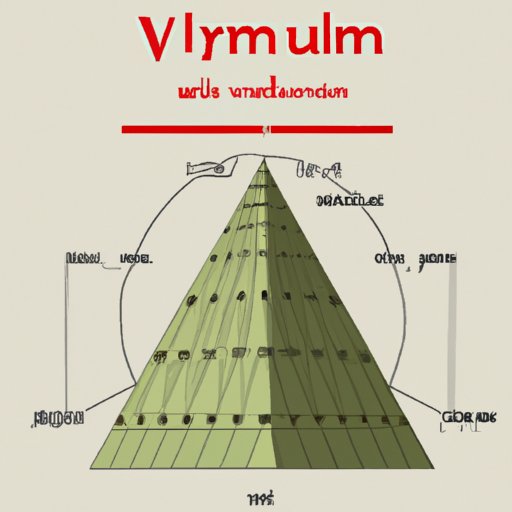
Introduction:
Pyramids are one of the most intriguing shapes in mathematics. They have a strong historical association with ancient civilizations, and to this day, pyramids continue to fascinate people around the world. In this article, we will discuss what pyramids are and how to find their volume.
Step-by-Step Tutorial:
Calculating the volume of a pyramid may sound complicated at first, but it can be broken down into simple steps. The first step is to determine the base of the pyramid. Next, it is necessary to calculate the area of the base. Afterwards, determine the height of the pyramid and multiply it by the base area. Lastly, divide your calculation by 3 to find the final volume of the pyramid. Throughout each step, we will be providing examples and visuals to help clarify and solidify the understanding of the process.
Real-World Applications:
Understanding how to calculate pyramid volume can also have real-world benefits for practical applications. For example, imagine a shipping company that is trying to determine how many packages they can fit into a pyramid-shaped container. Knowing how to find the pyramid’s volume can help calculate how many packages can be shipped and how to best pack those packages together. Furthermore, civil engineering projects that use pyramidical structures can benefit from knowing how to find the volume-equation in order to determine costs and required amount of material needed for construction
Visual Aids:
Visual aids can greatly improve the understanding of how to calculate pyramid volume. For example, instructional videos or infographics can provide an easy-to-understand step-by-step guide. There are free resources online that offer helpful videos and graphics to help learners understand the concept, such as Khan Academy or educational YouTube channels.
Formulas and Equations:
One common method for calculating the volume of a pyramid is to use the initial formula V = (1/3) x b x h, where ‘b’ represents the base area and ‘h’ represents the height of the pyramid. The base area can vary according to the shape of the base. It can be a triangle, a square or any other polygon. However, calculating base area, and thus volume, may be more complicated if the base happens to be an irregular shape. This is why different formulas and equations may be used based on the type of pyramid in question and different geometric theorem.
Common Mistakes:
There are common mistakes that can occur when calculating the volume of a pyramid. One common mistake is using the wrong formula or incorrect base measurements. It is important to remember to use the correct formula for the pyramid in question, and to double-check measurements before calculations. To avoid making errors, check out pre-made calculators or utilize a geometry textbook to show the ins-and-outs of making such calculations.
Practice Problems:
A great way to solidify the understanding of pyramid volume is to practice completing a series of problems. This not only helps with cementing topics but strengthens the ability to recognize which formula is to be used based on the given pyramid’s shape and base.
Historical Context:
Lastly, understanding the historical context of pyramids can help to deepen the appreciation of this iconic shape. Pyramids were first constructed by ancient Egyptians as tombs for pharaohs and continued to develop afterward. Historians strongly believe that this shape was instrumental in ancient Indian architecture, South African structures and even Mayan constructions.
Conclusion:
Calculating pyramid volume may seem difficult at the outset, but by breaking it down into smaller parts, anyone can master the process. The benefits are not only conceptual in nature but give one a clearer insight into ancient mathematics. By knowing how to find pyramid volume, there is no doubt that many people will find practical and useful applications in everyday life.





